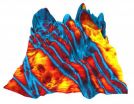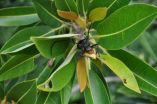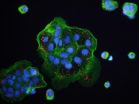(Press-News.org) Northwestern University graduate student Jonathan Barnes had a hunch for creating an exotic new chemical compound, and his idea that the force of love is stronger than hate proved correct. He and his colleagues are the first to permanently interlock two identical tetracationic rings that normally are repelled by each other. Many experts had said it couldn't be done.
On the surface, the rings hate each other because each carries four positive charges (making them tetracationic). But Barnes discovered by introducing radicals (unpaired electrons) onto the scene, the researchers could create a love-hate relationship in which love triumphs.
Unpaired electrons want to pair up and be stable, and it turns out the attraction of one ring's single electrons to the other ring's single electrons is stronger than the repelling forces.
The process links the rings not by a chemical bond but by a mechanical bond, which, once in place, cannot easily be torn asunder.
The study detailing this new class of stable organic radicals will be published Jan. 25 by the journal Science.
"It's not that people have tried and failed to put these two rings together -- they just didn't think it was possible," said Sir Fraser Stoddart, a senior author of the paper. "Now this molecule has been made. I cannot overemphasize Jonathan's achievement -- it is really outside the box. Now we are excited to see where this new chemistry leads us."
Sir Fraser is the Board of Trustees Professor of Chemistry in the Weinberg College of Arts and Sciences at Northwestern. In the late 1980s, he was one of the early pioneers to introduce an additional type of bond, the mechanical bond, into chemical compounds.
The new Northwestern compound has attractive electronic characteristics and can be made quickly and inexpensively. Down the road, it may be possible to expand this first linked pair into a longer chain-like polymer where this methodology could be useful in new technologies for batteries, semiconductors and electronic memory devices.
Driven by curiosity, Barnes only began to look at the radical chemistry of the ring cyclobis (paraquat-p-phenylene) two years ago, nearly 25 years after the ring was first made.
"I wondered what would happen if we took it all the way to the max," said Barnes, the paper's first author and a member of Stoddart's group. "Can we take two of these rings, each with four positive charges, and make them live together?"
The rings repel each other like the positive poles of two magnets. Barnes saw an opportunity where he thought he could tweak the chemistry by using radicals to overcome the hate between the two rings.
"We made these rings communicate and love each other under certain conditions, and once they were mechanically interlocked, the bond could not be broken," Barnes said.
Barnes' first strategy -- adding electrons to temporarily reduce the charge and bring the two rings together -- worked the first time he tried it. He, Stoddart and their colleagues started with a full ring and a half ring that they then closed up around the first ring (using some simple chemistry), creating the mechanical bond.
When the compound is oxidized and electrons lost, the strong positive forces come roaring back -- "It's hate on all the time," Barnes said -- but then it is too late for the rings to be parted. "That's the beauty of this system," he added.
Most organic radicals possess short lifetimes, but this unusual radical compound is stable in air and water. The compound tucks the electrons away inside the structure so they can't react with anything in the environment. The tight mechanical bond endures despite the unfavorable electrostatic interactions.
The two interlocked rings house an immense amount of charge in a mere cubic nanometer of space. The compound, a homo[2]catenane, can adopt one of six oxidation states and can accept up to eight electrons in total.
"Anything that accepts this many electrons has possibilities for batteries," Barnes said.
"Applications beckon," Stoddart agreed. "Now we need to spend more time with materials scientists and people who make devices to see how this amazing compound can be used."
###
The paper is titled "A Radically Configurable Six-State Compound."
In addition to Stoddart and Barnes, other authors of the paper are Albert C. Fahrenbach, Dennis Cao, Scott M. Dyar, Marco Frasconi, Marc A. Giesener, Oleksandr Chernyashevskyy, Hao Li, Srinivasan Sampath, Charlotte L. Stern, Amy A. Sarjeant, Karel J. Hartlieb, Zhichang Liu, Raanan Carmieli, Youssry Y. Botros, John B. Ketterson and Michael R. Wasielewski, of Northwestern; Diego Benítez, Ekaterina Tkatchouk and William A. Goddard III, of the California Institute of Technology; Weon Ho Shin and Jang Wook Choi, of the Korea Advanced Institute of Science and Technology; and Alexandra M. Z. Slawin, of the University of St. Andrews.
Love triumphs over hate to make exotic new compound
Compound could be useful in batteries, semiconductors and electronic memory devices
2013-01-25
ELSE PRESS RELEASES FROM THIS DATE:
Science needs a second opinion: Researchers find flaws in study of patients in 'vegetative state'
2013-01-25
NEW YORK (Jan. 24, 2013) -- A team of researchers led by Weill Cornell Medical College is calling into question the published statistics, methods and findings of a highly publicized research study that claimed bedside electroencephalography (EEG) identified evidence of awareness in three patients diagnosed to be in a vegetative state.
The new reanalysis study led by Weill Cornell neurologists Drs. Andrew Goldfine, Jonathan Victor, and Nicholas Schiff, published in the Jan. 26 issue of the journal Lancet, reports the statistical results and methodology used by a research ...
Chameleon pulsar baffles astronomers
2013-01-25
Using a satellite X-ray telescope combined with terrestrial radio telescopes the pulsar was found to flip on a roughly half-hour timescale between two extreme states; one dominated by X-ray pulses, the other by a highly-organised pattern of radio pulses.
The research was led by Professor Wim Hermsen from The Netherlands Institute for Space Research and the University of Amsterdam and will appear in the journal Science on the 25th January 2013.
Researchers from Jodrell Bank Observatory, as well as institutions around the world, used simultaneous observations with the ...
Genetic landscape of common brain tumors holds key to personalized treatment
2013-01-25
Nearly the entire genetic landscape of the most common form of brain tumor can be explained by abnormalities in just five genes, an international team of researchers led by Yale School of Medicine scientists report online in the Jan. 24 edition of the journal Science. Knowledge of the genomic profile of the tumors and their location in the brain make it possible for the first time to develop personalized medical therapies for meningiomas, which currently are only managed surgically.
Meningioma tumors affect about 170,000 patients in the United States. They are usually ...
New Year brings (potentially) good news for conservation of species on Earth
2013-01-25
Claims that most species will go extinct before they can be discovered have been debunked in the latest issue of Science, by researchers from The University of Auckland, Griffith University, and the University of Oxford.
The scientists show that the claims are based on two key misconceptions: an over-estimation of how many species may exist on Earth, and the erroneous belief that the number of taxonomists (people who describe and identify species) is declining.
"Our findings are potentially good news for the conservation of global biodiversity," says lead author Associate ...
Organic ferroelectric molecule shows promise for memory chips, sensors
2013-01-25
At the heart of computing are tiny crystals that transmit and store digital information's ones and zeroes. Today these are hard and brittle materials. But cheap, flexible, nontoxic organic molecules may play a role in the future of hardware.
A team led by the University of Washington in Seattle and the Southeast University in China discovered a molecule that shows promise as an organic alternative to today's silicon-based semiconductors. The findings, published this week in the journal Science, display properties that make it well suited to a wide range of applications ...
HIV-like viruses in non-human primates have existed much longer than previously thought
2013-01-25
Viruses similar to those that cause AIDS in humans were present in non-human primates in Africa at least 5 million years ago and perhaps up to 12 million years ago, according to study published January 24 in the Open Access journal PLOS Pathogens by scientists at Fred Hutchinson Cancer Research Center. Until now, researchers have hypothesized that such viruses originated much more recently.
HIV-1, the virus responsible for AIDS, infiltrated the human population in the early 20th century following multiple transmissions of a similar chimpanzee virus known as SIVcpz. Previous ...
Bats split on family living
2013-01-25
For the tiny Daubenton's bat, the attractions of family life seem to vary more with altitude than with the allure of the opposite sex.
For more than a decade, a team led by Professor John Altringham from the University of Leeds' School of Biology has studied a population of several hundred bats along a 50-km stretch of the River Wharfe. They monitored roosts in Ilkley and Addingham, upstream in the market town of Grassington and higher still in the villages of Kettlewell and Buckden.
The researchers found that all Daubenton's bats in nursery roosts in lowland areas ...
Extinction rates not as bad as feared ... for now
2013-01-25
Concerns that many animals are becoming extinct, before scientists even have time to identify them, are greatly overstated according Griffith University researcher, Professor Nigel Stork.
Professor Stork has taken part in an international study, the findings of which have been detailed in "Can we name Earth's species before they go extinct?" published in the journal Science.
Deputy Head of the Griffith School of Environment, Professor Stork said a number of misconceptions have fuelled these fears, and there is no evidence that extinction rates are as high as some have ...
Organizing human specimen collections: Getting the best out of biobanks
2013-01-25
The diversity of biobanks, collections of human specimens from a variety of sources, raises questions about the best way to manage and govern them, finds a study published in BioMed Central's open access journal Genome Medicine. The research highlights difficulties in standardizing these collections and how to make these samples available for research.
Biobanks have been around for decades, storing hundreds of millions of human specimens. But there has been a dramatic increase in the number of biobanks in the last ten years, since the human genome sequencing project. ...
Immune cell suicide alarm helps destroy escaping bacteria
2013-01-25
CHAPEL HILL, N.C. – Cells in the immune system called macrophages normally engulf and kill intruding bacteria, holding them inside a membrane-bound bag called a vacuole, where they kill and digest them.
Some bacteria thwart this effort by ripping the bag open and then escaping into the macrophage's nutrient-rich cytosol compartment, where they divide and could eventually go on to invade other cells.
But research from the University of North Carolina School of Medicine shows that macrophages have a suicide alarm system, a signaling pathway to detect this escape into ...
LAST 30 PRESS RELEASES:
Low daily alcohol intake linked to 50% heightened mouth cancer risk in India
American Meteorological Society announces Rick Spinrad as 2026 President-Elect
Biomass-based carbon capture spotlighted in newly released global climate webinar recording
Illuminating invisible nano pollutants: advanced bioimaging tracks the full journey of emerging nanoscale contaminants in living systems
How does age affect recovery from spinal cord injury?
Novel AI tool offers prognosis for patients with head and neck cancer
Fathers’ microplastic exposure tied to their children’s metabolic problems
Research validates laboratory model for studying high-grade serous ovarian cancer
SIR 2026 delivers transformative breakthroughs in minimally invasive medicine to improve patient care
Stem Cell Reports most downloaded papers of 2025 highlight the breadth and impact of stem cell research
Oxford-led study estimates NHS spends around 3% of its primary and secondary care budget on the health impacts of heat and cold in England
A researcher’s long quest leads to a smart composite breakthrough
Urban wild bees act as “microbial sensors” of city health.
New study finds where you live affects recovery after a hip fracture
Forecasting the impact of fully automated vehicle adoption on US road traffic injuries
Alcohol-related hospitalizations from 2016 to 2022
Semaglutide and hospitalizations in patients with obesity and established cardiovascular disease
Researchers ‘listen in’ to embryo-mother interactions during implantation using a culture system replicating the womb lining
How changing your diet could help save the world
How to make AI truly scalable and reliable for real-time traffic assignment?
Beyond fragmented markets: A new framework for efficient and stable ride-pooling
Can shape priors make road perception more reliable for autonomous driving?
AI tracks nearly 100 years of aging research, revealing key trends and gaps
Innovative techniques enable Italy’s first imaging of individual trapped atoms
KIER successfully develops Korea-made “calibration thermoelectric module” for measuring thermoelectric device performance
Diversifying US Midwest farming for stability and resilience
Emphasizing immigrants’ deservingness shifts attitudes
Japanese eels, climate change, and river temperature
Pusan National University researchers discover faster, smarter heat treatment for lightweight magnesium metals
China’s 2024 Gastroenterology Report: marked progress in endoscopy quality and disease management
[Press-News.org] Love triumphs over hate to make exotic new compoundCompound could be useful in batteries, semiconductors and electronic memory devices


